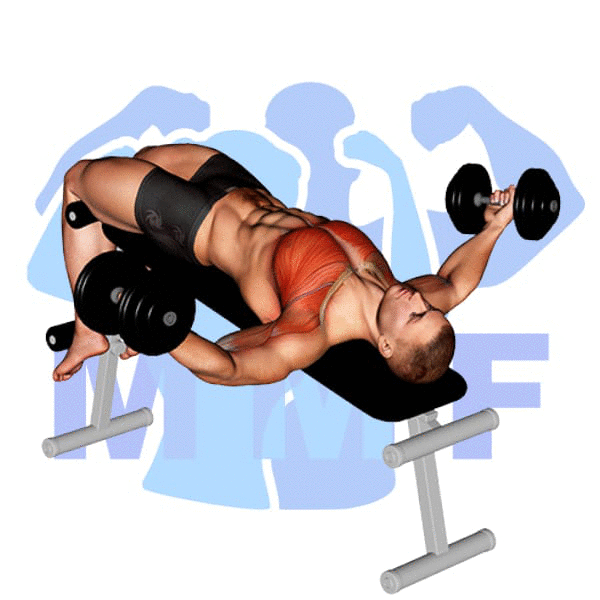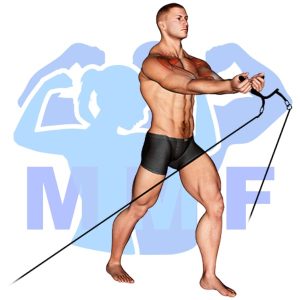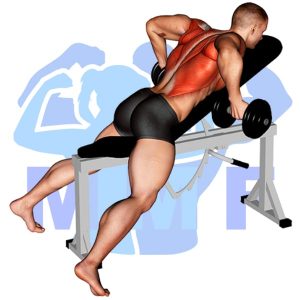Are you tired of tirelessly working out and not seeing the results you desire? Do you find yourself struggling with your chest exercises, particularly the decline dumbbell twist fly? Fear not, for you are not alone. Many people encounter similar obstacles when it comes to building their chest muscles. The cause often lies in the incorrect execution of the exercise or a lack of knowledge on how to properly target the targeted muscles. Luckily, this blog post will provide you with all the information you need to successfully perform the decline dumbbell twist fly and see the results you desire.
Decline Dumbbell Twist Fly Summary
- Primary Muscles: Pectoralis Major – Sternal
- Secondary Muscles: Latissimus Dorsi, Levator Scapulae, Pectoralis Major – Clavicular, Pectoralis Minor, and Rhomboids
- Equipment: Dumbbells and Bench
- Mechanics Type: Isolation
- Force: Push
- Utility: Auxiliary

Decline Dumbbell Twist Fly Instructions
- Pick up some dumbbells in this case not to heavy, then lay down on the decline bench.
- Bring the dumbbells out to your side and lock your elbow slightly bent with your palms up.
- Next, bring the dumbbells together above your chest and rotate your wrists so that your palms are facing towards you head.
- Then lower the dumbbells back down to your side while rotating your palms back to facing up.
- Do it again until you have performed your needed reps.
Video Tutorial
Decline Dumbbell Twist Fly Muscles
Target (Agonist)
- Pectoralis Major, Sternal
Synergists
- Latissimus Dorsi
- Levator Scapulae
- Pectoralis Major – Clavicular
- Pectoralis Minor
- Rhomboids
Dynamic Stabilizers
- None
Stabilizers
Antagonist Stabilizers

Benefits of Decline Dumbbell Twist Fly
The Decline Dumbbell Twist Fly is a great exercise for targeting the Pectoralis Major – Sternal. It is an effective way to increase strength in the chest area and to build muscle mass. This exercise is great for improving upper body posture, increasing stability in the shoulder joint, and developing core strength. It can also help to improve range of motion in the chest area and increase flexibility in the shoulder joint. This exercise can be easily modified to focus on specific areas of the chest and can be performed with a variety of weights. Performing this exercise regularly will help to develop a stronger and more defined chest area, as well as improve overall fitness and health.
Tips for Performing Decline Dumbbell Twist Fly
For you to have the best improvement, you must focus on these timeless tips. Also, if you need to minimize your likelihood of an injury, you need to understand these tips.
- To Improve Power And Speed, Bring Up The Velocity Of Your Movements. Maintain nice form or you might be more suboptimal to injury. You ought to reduce the weight to 50-60% of your 1RM when lifting for speed. However, you need to stop between every rep.
- Deciding On A Recovery Period To Be Quick, But You Can Still Accomplish A Entire Set. Every time your break period is to short you could not be able to perform your entire set, if it is too long you will be simply being inefficient.
- Complete the Proper Quantity Of Sets Utilizing Rest. Your goal initially might be to do 3 sets to near fatigue. In reality, you can build up to 5 sets. If your muscles aren’t exhausted at the end of 3 – 5 some thing should change. Initially you can increase the resistance to make each rep tougher. Next you can cut down on the rest time between each set.
- Slow Down All Repetition To About 5 Seconds For Every Contraction And The Same For The Extension, To Speed Up Your Workout. So that you will develop bulk you need to maximize the time under strain of your primary muscle tissue. Slowing your execution will improve the time period under strain. Multiple research papers have revealed that 4-6 seconds extension and contraction is the ideal time provides maximal benefit for creating muscle gains. You need to include this strategy once in a while, and not every time you lift.
Benefits and Tips Video
Frequent Mistakes To Avoid
You must keep from making these fairly typical errors to build and maintain ideal technique and see large gains. Additionally, when you stay away from these issues you will decrease the probability of having to deal with an injury.
- Don’t Allow Yourself To Cheat. In the majority of the time, cheating is utilizing momentum as a substitute for the strength of your main muscle tissue. Occasionally, some cheating on your last rep can be beneficial to overload your muscle, however not for more than a handful of reps.
- You Can’t implement inadequate technique. Poor technique can be a fast path to surely have a physical injury.
- You Must Not Attempt To Lift More Weight Than You Can Do Correctly. You’re likely to forfeit your form and can cause a physical injury when you make an attempt to lift more than you should.
Find More Dumbbell Exercises Here
Variations and Complementary Exercises
Although the Decline Dumbbell Twist Fly is a great exercise to target your upper body, there are some variations, complementary, or alternative exercises that can be done to further develop your muscles. Here is a list of exercises that you can incorporate into your routine to get the most out of your workout.
Dumbbell Fly

The Dumbbell Fly is a great complementary or alternative exercise to the Decline Dumbbell Twist Fly. This exercise targets the same muscles, but works them in a different way. It is an isolation exercise that focuses on the chest and shoulder muscles and requires the user to lie on a flat bench while holding dumbbells with both hands. The arms are then opened out wide and brought together again in an arc, squeezing the chest muscles at the top of the movement. This exercise is great for building strength and definition, as well as increasing muscular endurance.
Incline Dumbbell Fly

Incline Dumbbell Fly is a great complementary or alternative exercise to the Decline Dumbbell Twist Fly. This exercise works the same muscles as Decline Dumbbell Twist Fly, but with a different angle. When performing Incline Dumbbell Fly, you start by lying on an incline bench with a dumbbell in each hand and your arms extended straight up. Then lower your arms out to the side and back up again, keeping your elbows slightly bent. This exercise targets your chest, shoulders and triceps, making it a great way to build strength and stability in these muscle groups.
Incline Dumbbell Twisted Flyes

Incline Dumbbell Twisted Flyes are an excellent complementary or alternative exercise to Decline Dumbbell Twist Fly. This exercise works the same muscle group as the Decline Dumbbell Twist Fly, but with a slightly different angle. The inclined plane of the bench puts more stress on the upper chest, shoulders, and arms than the decline. With this exercise, you will be able to target specific muscles and increase your range of motion. Additionally, it is a great way to add intensity to your workout while avoiding strain on the lower back.
Check Out These Top Dumbbell Exercises
Low Cable Fly

The Low Cable Fly is an excellent alternative or complementary exercise to the Decline Dumbbell Twist Fly. This exercise works the same muscles as the Decline Dumbbell Twist Fly but in a slightly different way. The Low Cable Fly is performed by attaching two handles to a low cable machine and standing in between them with your arms outstretched. You then pull the handles towards each other while keeping your arms straight, bringing your hands together in front of your chest. This exercise targets the same muscles as the Decline Dumbbell Twist Fly but with a greater range of motion and more emphasis on the chest muscles. Additionally, the use of the cable machine allows for a more controlled movement and allows for greater resistance to be used.
Lying Cable Flys

Lying Cable Flys can be a great complementary or alternative exercise to the Decline Dumbbell Twist Fly. This exercise is performed on a flat bench while lying face up, with two cable pulleys set at chest level. To perform Lying Cable Flys, grip the handles of the pulleys and press them away from your chest in a wide arc, keeping your arms slightly bent. Then, slowly bring the pulleys back to the starting position. This exercise helps to strengthen the chest muscles and helps to increase overall chest strength and size.
Stability Ball Cable Flys

Stability Ball Cable Flys are a great alternative exercise for the Decline Dumbbell Twist Fly. This exercise helps to isolate the chest and shoulder muscles, while at the same time engaging your core. The stability ball helps to keep your body stable, which helps to avoid any unnecessary strain on your joints. This exercise is also a great way to challenge your balance and stability as you move through the motion. The cable fly gives you the option to adjust the resistance levels, making it a great way to target different muscle groups.
Find More Chest Exercises Here
Opposing Complementary Exercises
To ensure that you get a complete workout, it is important to include exercises that complement the Decline Dumbbell Twist Fly by using opposing muscle groups. This will help to prevent imbalances and ensure that all your muscles are engaged and challenged. Here are some exercises that do just that:
Underhand Dumbbell Row

The Underhand Dumbbell Row is an excellent complement to the Decline Dumbbell Twist Fly. The Underhand Dumbbell Row works the back muscles, specifically the latissimus dorsi, in the opposite direction of the Decline Dumbbell Twist Fly, which works the chest muscles. This opposing muscle group combination helps to ensure that the muscles are balanced and symmetrical. Additionally, the Underhand Dumbbell Row helps to engage and strengthen the back muscles, which are essential for good posture and overall health.
Barbell Pendlay Row

The Barbell Pendlay Row is an excellent exercise to pair with the Decline Dumbbell Twist Fly. This exercise targets the back muscles and is a great way to strengthen and develop the muscles that oppose those worked in the Decline Dumbbell Twist Fly. Specifically, the Barbell Pendlay Row works the lats, traps, and rhomboids, while the Decline Dumbbell Twist Fly works the chest muscles. Performing both of these exercises in tandem will help create balanced development in your upper body and create a stronger, more toned physique.
Barbell Reverse Grip Bent Over Row

The Barbell Reverse Grip Bent Over Row is an excellent complementary exercise to the Decline Dumbbell Twist Fly. This exercise primarily targets the lats and lower back muscles, which are opposing muscle groups to those used in the Decline Dumbbell Twist Fly. The bent over row allows for a greater range of motion and more muscle activation than the fly, resulting in increased strength and size. By performing both exercises together, you can maximize the effects of your workout and improve overall balance and strength.
Get Twistin’ with the Dumbbell Decline Fly!
If you’re looking to add some twist to your chest and shoulder workout, then the Dumbbell Decline Fly is the perfect exercise for you. This move targets your lower and mid-chest while also engaging your shoulders and triceps. The decline angle of the bench puts more emphasis on the lower chest, making this exercise great for those looking to build a well-rounded chest. Adding a twisting motion to this exercise not only makes it more challenging but also engages your core, helping you build a strong and stable midsection. Incorporate this exercise into your routine to give your chest and shoulders the twist they need!
References: Wikipedia | ExRx.net | PubMed.gov | Comprehensive List of Chest Dumbbell Exercises




